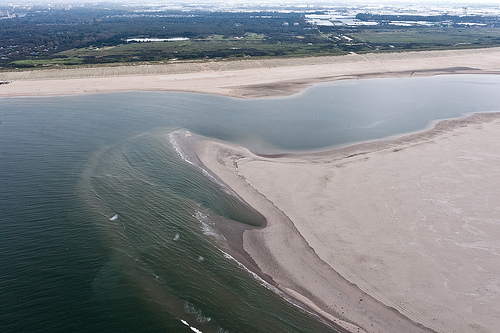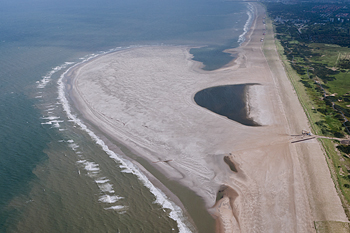North point of Sand Motor is already at work
The effect of the Sand Motor is quite evident from the beach, just south of The Hague. The construction of the artifical hook-shaped peninsulathe is almost completed. The principals of the project Rijkswaterstaat and the province of South Holland report that the north point has already started to move towards the beach. And on the side of the beach a new curve has been observed growing towards the Sand Engine. The Sand Motor is already at work. The constructed bay is narrowing faster than expected. Possibly the bay closes itself.
The past weeks it has been observed that the northern tip of Sand Motor has two sandbars are moving and after each flood the situiation has changed. The monitoring team of Rijkswaterstaat accurately maps the new developments.
Sand naturally spread along the coast
The Sand Motor is an innovative method for coastal protection. It is created by the suppletion of 21,5 million cubic meter of sand, along the coast of South-Holland at Ter Heijde, just sout oif The Hague, in 2011. Wind, waves and currents will spread the sand naturally along the coast of South-Holland. The Sand Motor will gradually change in shape and will eventually befully incorporated into the dunes and the beach. The coast will be broader and safer.
Building with nature
The Sand Motor is a great example of building with nature. By depositing a large amount of sand in a single operation, we can avoid repeated disruption of the vulnerable seabed. Nature will take the sand to the right place for us. If the Sand Motor fulfils our expectations, sand replenishment off the Delfland Coast will be unnecessary for the next 20 years.
First experiment of its kind
The Sand Motor is the first experiment of its kind. With this pilot project, the Netherlands is continuing to set the standard in water management. In 2011, we are doing this by actually working with water, instead of against it. If the Sand Motor works as we expect, the concept can be rolled out to other places in the Netherlands and the rest of the world.
Mapping out the new currents
Scientists will be studying how the Sand Motor develops to see whether this innovative method for coastal protection does indeed work. Measurement data are also needed to manage the Sand Motor properly. One example is mapping out new currents so we know where it is safe to bathe. But we also want to see which animals visit the Sand Motor, and how visitors spend their leisure time on the Sand Motor.
The principles of the project are Rijkswaterstaat and the provincie of South Holland and the contractor is Van Oord/Boskalis Combination.
More information
Project office Sand Motor
zandmotor@kustvisiezuidholland.nl
|www.dezandmotor.nl
Photo: Rijkswaterstaat/Joop van Houdt





